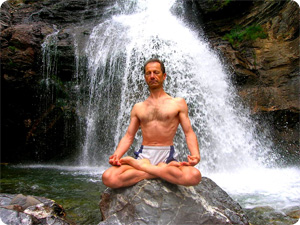An insightful and informative article about Yoga's
eight-fold path to enlightenment.
While many consider Yoga to be a form a physical
exercise, it is also known to be an exercise in spiritual development. Most would agree that the true goal of Yoga
is to provide the individual with the means to achieve inner peace and
balance. To achieve these lofty goals,
students are encouraged to become familiar Yoga's eight fold path. The eight fold path consists of eight
disciplines; Yama, Niyama, Asana, Pranayama, Pratyahara, Dharana, Dhyana, and
Samhadi.
The first fold, Yama, advises students to engage with the world from a moral standpoint, and is actually broken down into five distinct elements. The first element, Ahimsa, teaches the student to respect the world around him. The second, Satya, teaches that one should be honest with themselves and with others. The third, Asteya, teaches not to steal from another. The fourth, Bramacharya, advises against overindulgence of any form. The fifth, Aparigraha, teaches the student to live a simple life that is not distracted by material things.
Niyama, or the second fold, is considered the path of self restraint and consists of three distinct elements. Shaugh, the first element, teaches students to keep the body and mind clean and pure. Santosh, the second element, teaches the student to be happy and contented with the task at hand and to give an honest effort in all endeavors. Tapa, the third element, suggests that certain pleasures must be given up in order to attain one's goals.
Asana is the third of the eight fold path, and it is concerned with physical training and building stamina. Asana is made up of 84 yoga poses, which are focused on developing strength, increasing health, and preparing for meditation. This stage is as much about physical conditioning, as it is mental or psychological discipline. Pranayama, the fourth fold, concerns controlled breathing. Proper breathing is important for mastering true relaxation and self discipline. The proper way to breathe while practicing yoga is to breathe in, and breathe out while pausing in between.
Pratyahara is the fifth of the eight folds, and is concerned with the individual's control of sensory stimulation. The intent is to induce a sense of inner peace and quiet, by tuning out external stimulation. Dharana is the sixth fold, and it is primarily concerned with focusing one's concentration on meditation. When a meditative state has been attained the student is then on to the seventh step, Dhyana. The final step, Samhadi, is attained when all previous steps have been completed and the individual experiences a true oneness with all things. The student is, as of this point, in tune with the universal flow. Namaste!
The first fold, Yama, advises students to engage with the world from a moral standpoint, and is actually broken down into five distinct elements. The first element, Ahimsa, teaches the student to respect the world around him. The second, Satya, teaches that one should be honest with themselves and with others. The third, Asteya, teaches not to steal from another. The fourth, Bramacharya, advises against overindulgence of any form. The fifth, Aparigraha, teaches the student to live a simple life that is not distracted by material things.
Niyama, or the second fold, is considered the path of self restraint and consists of three distinct elements. Shaugh, the first element, teaches students to keep the body and mind clean and pure. Santosh, the second element, teaches the student to be happy and contented with the task at hand and to give an honest effort in all endeavors. Tapa, the third element, suggests that certain pleasures must be given up in order to attain one's goals.
Asana is the third of the eight fold path, and it is concerned with physical training and building stamina. Asana is made up of 84 yoga poses, which are focused on developing strength, increasing health, and preparing for meditation. This stage is as much about physical conditioning, as it is mental or psychological discipline. Pranayama, the fourth fold, concerns controlled breathing. Proper breathing is important for mastering true relaxation and self discipline. The proper way to breathe while practicing yoga is to breathe in, and breathe out while pausing in between.
Pratyahara is the fifth of the eight folds, and is concerned with the individual's control of sensory stimulation. The intent is to induce a sense of inner peace and quiet, by tuning out external stimulation. Dharana is the sixth fold, and it is primarily concerned with focusing one's concentration on meditation. When a meditative state has been attained the student is then on to the seventh step, Dhyana. The final step, Samhadi, is attained when all previous steps have been completed and the individual experiences a true oneness with all things. The student is, as of this point, in tune with the universal flow. Namaste!
Keywords:
Yama, Asana, Dharana, Dhyana, Samhadi

.jpg)
